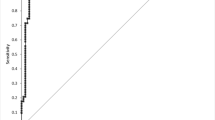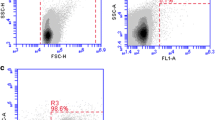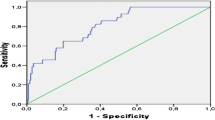Abstract
Purpose
To exclude urinary tract infections, culture is the gold standard method, although it is time consuming and costly. Current strategies using dipstick analysis are unsatisfactory as screening methods, because of inadequate sensitivity/specificity. Urine flow cytometry is an attractive alternative. To exclude urinary tract infections, a cutoff value to screen for negative cultures was determined.
Methods
281 outpatients (51 % male) of a general population visiting the urology department were included. Urine samples were measured by flow cytometry and compared with culture results and dipstick analysis. ROC analysis was performed to evaluate the screening performance of flow cytometry and dipstick analysis compared to culture.
Results
18 % of cultures were positive, defined as >104 colony forming units/mL. Bacterial count by flow cytometry alone provides the best sensitivity and specificity to exclude a urinary tract infection. A cutoff value of 60 bacteria/μL urine leads to a sensitivity of 100 % and a specificity of 60 %. Retrospectively, with a cutoff value of 60 bacteria/μL urine, 49 % of the cultures would have been redundant. 20 % of patients receiving antibiotics possibly had received those unnecessarily. The calculated percentage of false negatives was 0 % (95 % confidence interval 0–3.3 %).
Conclusions
Urine flow cytometry is a reliable screening method to exclude urinary tract infections. With a cutoff value of 60 bacteria/μL urine, negative predictive value is 100 % and the calculated percentage of false negatives is 0 % (95 % confidence interval 0–3.3 %). Using flow cytometry as a screening method could lead to a reduction in cultures and antibiotics.


Similar content being viewed by others
References
Schmiemann G, Kniehl E, Gebhardt K, Matejczyk MM, Hummers-Pradier E (2010) The diagnosis of urinary tract infection. Dtsch Arztebl Int 107(21):361–367
Naber KG (2006) Urogenital infections: the pivotal role of the urologist. Euro Urol 50:657–659
Bader MS, Hawboldt J, Brooks A (2010) Management of complicated urinary tract infections in the era of antimicrobial resistance. Postgrad Med 122(6):7–15
Costelloe C, Metcalfe C, Lovering A, Mant D, Hay AD (2010) Effect of antibiotic prescribing in primary care on antimicrobial resistance in individual patients: systematic review and meta-analysis. BMJ 340:c2096
Jolkkonen S, Paattiniemi EL, Kärpänoja P, Sarkkinen H (2010) Screening of urine samples using flow cytometry reduces the need for culture. J Clin Microbiol 48(9):3117–3121
Van der Zwet WC, Hessels J, Canbolat F, Deckers MML (2010) Evaluation of the Sysmex UF-1000i® urine flow cytometer in the diagnostic work-up of suspected urinary tract infection in a Dutch general hospital. Clin Chem Lab Med 48(12):1765–1771
De Rosa R, Grosso S, Brushetta G, Avolio M, Stano P, Modolo ML, Camporese A (2010) Evaluation of the Sysmex UF1000i flow cytometer for ruling out bacterial urinary tract infection. Clin Chim Acta 411:1137–1142
Manoni F, Tinello A, Fornasiero L, Hoffer P, Temporin V, Valverde S, Gessoni G (2010) Urine particle evaluation: a comparison between the UF-1000i and quantitative microscopy. Clin Chem Lab Med 48(8):1107–1111
Pieretti B, Brunati P, Pini B, Colzani C, Congedo P, Rocchi M, Terramocci R (2010) Diagnosis of bacteriuria and leukocyturia by automated flow cytometry compared with urine culture. J Clin Microbiol 48(11):3990–3996
European confederation of laboratory medicine (2000) European urinalysis guidelines. Scand J Clin Lab Invest Suppl 231:1–86
Thompson R, Gammie A, Lewis D, Smith R, Edwards C (2010) Evidence review: automated urine screening systems. NHS Purchas Supply Agency CEP10030:1–46
Brilha S, Proença H, Cristino JM, Hänscheid T (2010) Use of flow cytometry (Sysmex® UF-100) to screen for positive urine cultures: in search for the ideal cut-off. Clin Chem Lab Med 48(2):289–292
Broeren MAC, Bahçeci S, Vader HL, Arents NLA (2011) Screening for urinary tract infection with the sysmex UF-1000i urine flow cytometer. J Clin Microbiol 49(3):1025–1029
Dutch General Practitioners Society (NHG) (2005) NHG guideline for urinary tract infections
Wang J, Zhang Y, Xu DW, Shao W, Lu Y (2010) Evaluation of the Sysmex UF-1000i for the diagnosis of urinary tract infection. Am J Clin Pathol 133:577–582
Conflict of interest
The authors declare that they have no conflict of interest.
Author information
Authors and Affiliations
Corresponding author
Rights and permissions
About this article
Cite this article
Boonen, K.J.M., Koldewijn, E.L., Arents, N.L.A. et al. Urine flow cytometry as a primary screening method to exclude urinary tract infections. World J Urol 31, 547–551 (2013). https://doi.org/10.1007/s00345-012-0883-4
Received:
Accepted:
Published:
Issue Date:
DOI: https://doi.org/10.1007/s00345-012-0883-4




